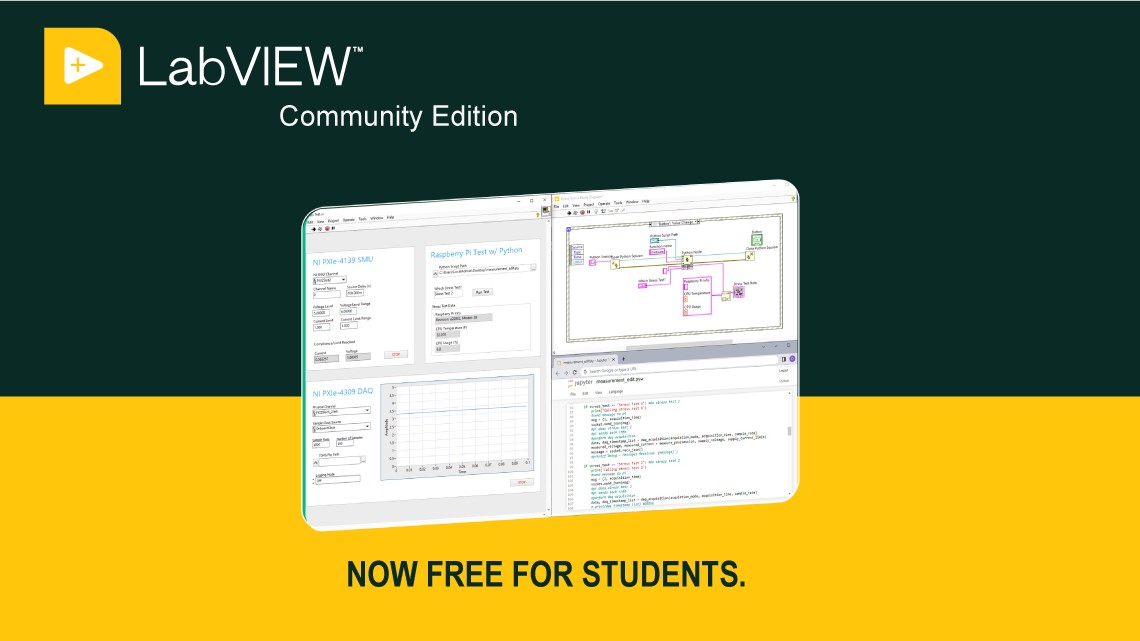
Delivering on NI’s Promise to Strengthen LabVIEW
EXPERT OPINION
LabVIEW | 8 MINUTE READ
NI’s strategic vision for LabVIEW includes improved Git integration, advanced security protocols, expanded language support, and AI-driven testing innovations that can transform the engineering workflow.
AUTHOR: Graham Green, Head of Test Software
Previously, I wrote in “Charting a course for LabVIEW” how NI was committed to deliver three fundamental values of NI LabVIEW:
- We would Strengthen our core software products: delivering a roadmap for LabVIEW, NI TestStand, and our other test software that we are proud of, and you are excited about!
- We would Connect LabVIEW to an ecosystem of complementary tools that together add value across a test professional’s workflow—a suite of tools we now call LabVIEW+.
- We would support the LabVIEW Community, building ongoing success for our users, and including them more actively in NI strategy.
In the coming months, I want to dive one level deeper and discuss each of these three pillars to provide some insight into not just what we want to do but how we plan to do it. In this article, I focus on the first pillar: Strengthen LabVIEW.
Strengthening LabVIEW through Feature Development
Arguably the first two pillars are complementary. To strengthen LabVIEW, we must better connect to the LabVIEW+ ecosystem, meaning that any feature investment in one product benefits every user—but this connectivity roadmap is a story for another day. For now, let’s concentrate on feature development within LabVIEW, the graphical development environment used by tens of thousands of engineers every day, and our mainstream development tools TestStand, NI InstrumentStudio™ software, NI FlexLogger™, and NI DIAdem.
Of the numerous projects currently active within NI R&D, there are five that I would like to call out as they deliver impact across many different products and applications in the coming years.
1. Modern Development Practices
Most engineers don’t work alone, so effective collaborative development is essential. We received a lot of great input about how LabVIEW could improve; and starting this year, you should see step improvements to team development. Git integration of LabVIEW and TestStand are coming, as well as much improved diff and merge tools that provide more detailed and actionable descriptions of changes. After the 2024 Q3 release, you can take advantage of these latest development environment changes as well as things like zoom (introduced in 2023) without being forced to upgrade code to the latest version—this change will help developers in a shared-source settings or who must version lock but want to benefit from productivity enhancements.
2. Open Architectures
Here at NI, we know LabVIEW is the best software development tool for test and measurement. Both development and debugging are quick and intuitive, hardware connectivity is comprehensive, building user interfaces is easy, and you can drive performance with automatic multithreading and recompilation for real-time targets—what’s not to like! We also acknowledge that there is a lot of IP written in other languages that could add value to your projects.
In recent years, we have made strides in easing the use of MathWorks® MATLAB® software within the LabVIEW environment. Last year we enabled calling Python code in LabVIEW while running in a virtual environment, and we will soon enable calling of .NET 8 core assemblies too. This philosophy doesn’t stop at language support either; we are hard at work building the pin maps of third-party hardware into our software tools too to speed your development, whatever your test coverage! This commitment towards easy and open integration will continue as an ongoing theme across software product lines for years to come.
3. System Security
Software security is top of mind for many engineers today, and it will be for many more soon with tightening regulations in the US and EU. “Memory safe is a loaded term with many definitions across industry, but you should be confident that LabVIEW has some intrinsic advantages here. First off, the dataflow paradigm reduces the use of pointers in code, which is a huge benefit. Beyond this advantage, it is a directly compiled language that errors out if there is a buffer overflow and has no scripting at runtime, which allows greater certainty as to where your precious data is going.
NI is working to document and publish software bills of materials and third-party dependencies in response to increased global security standards. We have a dedicated team devoted to this subject and as security grows as a priority in your business, please work with NI and together we can ensure you have confidence in your compliance.
4. Generative AI
The whole world is talking about Generative AI—and with good reason. This technology isn’t just cool; it promises to be bigger than the internet or the smartphone in terms of impact. Test will not be an exception to this technology. We envisage systems with the ability to perceive, learn, and adapt to optimize outcomes. We call this “intelligent test,” and it should deliver the following benefits:
- Instrument Intelligence
o Enabling improved signal processing at the point of measurement
o Providing real-time insights into waveform features
o Adapting test flows in real time to reduce test time
o Distributing decision making throughout the system
- User Intelligence
o Accelerating validation and test workflows
o Optimizing test plans
o Enabling rapid data analysis and reporting
- Enterprise Intelligence
o Improving asset utilization
o Identifying manufacturing trends and defects
o Generating insights across the product lifecycle
To make these benefits more tangible to your day-to-day work in the short term, at NI Connect 2024 we demonstrated how AI could be used within LabVIEW to automate code description and documentation, which is a “must-have” feature for the common use case where an engineer inherits code with unclear operation. We also announced that we are currently engaged in a select early access program trialing this technology with LabVIEW and are collecting registrations for a broader program. Contact NI for more information.
5. Accelerated Development
The fundamentals of test and measurement don’t change much from one application to the next; it’s the last 10 percent that in most cases presents the unique engineering challenges. In the spirit of this obstacle, there continues to be huge opportunity in identifying common tasks and abstracting functionality into configuration-based workflows, enabling engineers to spend their time where it matters most. This process, of course, is not new to NI, with well-established tools like TestStand and DIAdem standardized across many engineering orgs. NI’s roadmap here focuses on improving their user interface, Linux desktop deployment, and improved Python integration.
However, NI sees huge opportunity to add value in this space with new tools, too. FlexLogger and InstrumentStudio are examples of our desire to open new ways for teams to quickly set up and run measurement tasks. These tools have active roadmaps that add further depth in measurement automation and customization functionality.
Building on this strategy further, we announced InstrumentStudio Professional at NI Connect 2024. This edition will extend the functionality of our popular PXI companion software, InstrumentStudio, to cover a larger portion of the electronic validation workflow, including automation and measurement customization. InstrumentStudio Pro is designed to work alongside LabVIEW—and TestStand and will automatically be added to LabVIEW+ suite license holders, improving the value they receive.
Strengthening LabVIEW will be a Collaborative Effort
NI remains committed to investing in LabVIEW and our core software products to deliver new functionality to you. I’ll also commit to regular communication of our roadmap. This article is just the beginning—I want to go deeper and broader with our LabVIEW community, getting your feedback to ensure our product is as good as it can be. To do this effectively, it must be a two-way dialog. Look out for upcoming onsite events, user group sessions, online webinars, and more on this subject where you can have your say on how we should progress.
I’ll finish by sharing NI’s belief that technology investment must be paired with investment to build a new pipeline of engineers. At NI Connect 2024, we announced that we are making LabVIEW Community Edition, originally introduced in 2019, FREE FOR STUDENTS. This step is just the first in investing back into both our academic and proficiency programs; I’ll write about this in more detail on pillar three: The Build LabVIEW Community.

This article represents the second in the series on software strategy. Look out for further pieces on connecting LabVIEW and the LabVIEW community coming soon.


